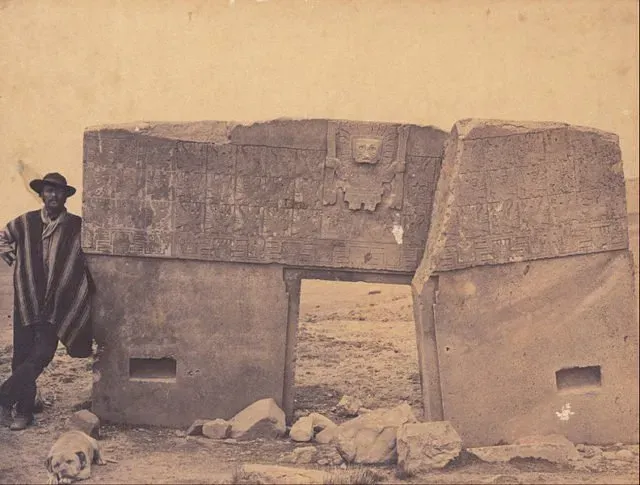This ancient "portal" was created from a single block of andesite weighing about 10 tons and measuring about 9.8 ft (3.0 m) high and 13 ft (4.0 m) wide. Some authors argue that it dates back to about 15,000 BC.
Located near one of the world's most magnificent lakes - Lake Titicaca - the Gate of the Sun was built thousands of years ago by an ancient culture that inhabited what is now Bolivia, at the archaeological site of Tiahuanaco.
Ever since European explorers stumbled upon the enigmatic structure, archaeologists, historians, and tourists have been fascinated by the Gate of the Sun.
Among experts, it is known as one of the best examples of the level of perfection that its building culture reached, both for the art and for the symbolism that treasures its reliefs.
Most experts agree that this "portal" was created from a single block of andesite weighing about 10 tons, and is approximately 9.8 feet (3.0 m) high and 13 feet (4.0 m) wide.
In the past, the Gate of the Sun was part of a larger structure, most likely located at the top of the Akapana Pyramid or at the Kalasasaya Temple, where there are several structures made of the same material as the Gate of the Sun.
The Gate of the Sun has curious representations on its surface, the most recognizable being that of Viracocha, who is depicted surrounded by winged creatures kneeling before him. Are these the same winged creatures we see in ancient Mesopotamia? There are 32 effigies with human faces and 16 with condor heads.
 |
| Rediscovered by European explorers in the mid-19th century. |
Viracocha is the great creator deity of pre-Inca and Inca mythology in the Andean region of South America. According to legend, Viracocha rose from Lake Titicaca during a time of darkness to bring light and create the sun, moon, and stars.
Curiously, this ancient deity is said to have CREATED mankind by breathing into stones, but his first creation were mindless giants who displeased him. So he destroyed them with a flood and made a new, better one out of smaller stones.
The Gate was never finished, as experts have found several unfinished figures, as if the carvers had hurriedly left behind one of their most magnificent structures.
The Gate of the Sun has a crack in the upper right corner that divides the stone in two. It is believed to have been struck by lightning, but this theory cannot be verified because there are no burn marks on or inside the stone.
If we take a look at some of the legends that mention giants, the door was cracked when it was thrown to the ground, splitting the Gate of the Sun in two.
This remains a mystery to archaeologists.
According to Aymara legend, the door holds a secret that the ancient Aymaras left hidden to help future humanity in need.
Today it is one of the most important monuments of Tiahuanaco.
Tiahuanaco - the city complex - was the center of the ancient Tiahuanaco civilization, an extremely well-developed pre-Inca culture that based its economy on agriculture, architecture and livestock.
The ancient culture covered the areas of the Collao Plateau, located between southwestern Peru, western Bolivia, northern Argentina and northern parts of Chile, regions from which the culture passed on its technological and religious influence to other contemporary civilizations.
The city of Tiahuanaco is characterized by its incredibly intricate architectural style, decorated with countless reliefs, which in turn are shrouded in mystery.
 |
| Gate of the Sun, rear view (1903). |
The city complex is made up of several important architectural structures: the Akapana, Akapana East, and Pumapunku stairways; the Kalasasaya, Kheri Kala, and Putuni enclosures; and the semi-subterranean temples, Puerta del Sol (Gate of the Sun), and Puma Punku, which in turn is decorated with numerous reliefs.
As noted in recent studies, these architectural examples, as well as the Akapana Gate, have unique detailing and demonstrate a high level of stonemasonry skill. This reveals a knowledge of descriptive geometry. The regularity of the elements suggests that they are part of a system of proportions.
It is believed that Tiahuanaco is one of the oldest cultures in South America, having survived from about 1500 B.C. to the year 1000 A.D.
The general consensus is that the ancient Tiahuanaco culture began around 1580 BC.
This ancient culture is characterized by the use of bronze tools and weapons, which gave them a great technological and military advantage over the other cultures in the Americas at that time in history; proof of this is that brass fittings have been found in their constructions, and several tools and weapons have been unearthed by experts.
Some authors, such as Arthur Posnansky, have estimated that Tiwanaku dates back to 15,000 BC, based on its archaeoastronomical techniques. [2]
Posnansky's theory is that after the great flood of around 11,000 BC, the survivors developed advanced agricultural techniques that are only now being studied by certain experts.
In particular, this ancient culture, through crossbreeding and techniques that are still not well understood, was able to obtain an excess production of maize, quinoa, kiwicha, potatoes and maca (a truly powerful nutrient that is still used today), despite the fact that the climate was excessively cooled.
In his famous book "Tiahuanaco, the Cradle of the American Man", Posnansky proposes two theories that, according to him, are essential for considering Tiahuanaco as the oldest city on the surface of the planet.
Because of its apparent antiquity, some scholars proposed that Tiahuanaco was the mother culture of all South American civilizations, while others considered it to be the capital of an ancient megalithic empire or a great empire that spread throughout the Central Andes.
Sources: ewao.com; Fernando Cajías de la Vega, La enseñanza de la historia : Bolivia, Convenio Andrés Bello, 1999,p.44.; Exploring Ancient Skies: A Survey of Ancient and Cultural Astronomy 2nd ed. 2011 Edition; Tihuanacu: The Cradle of American Man Hardcover – 1957
